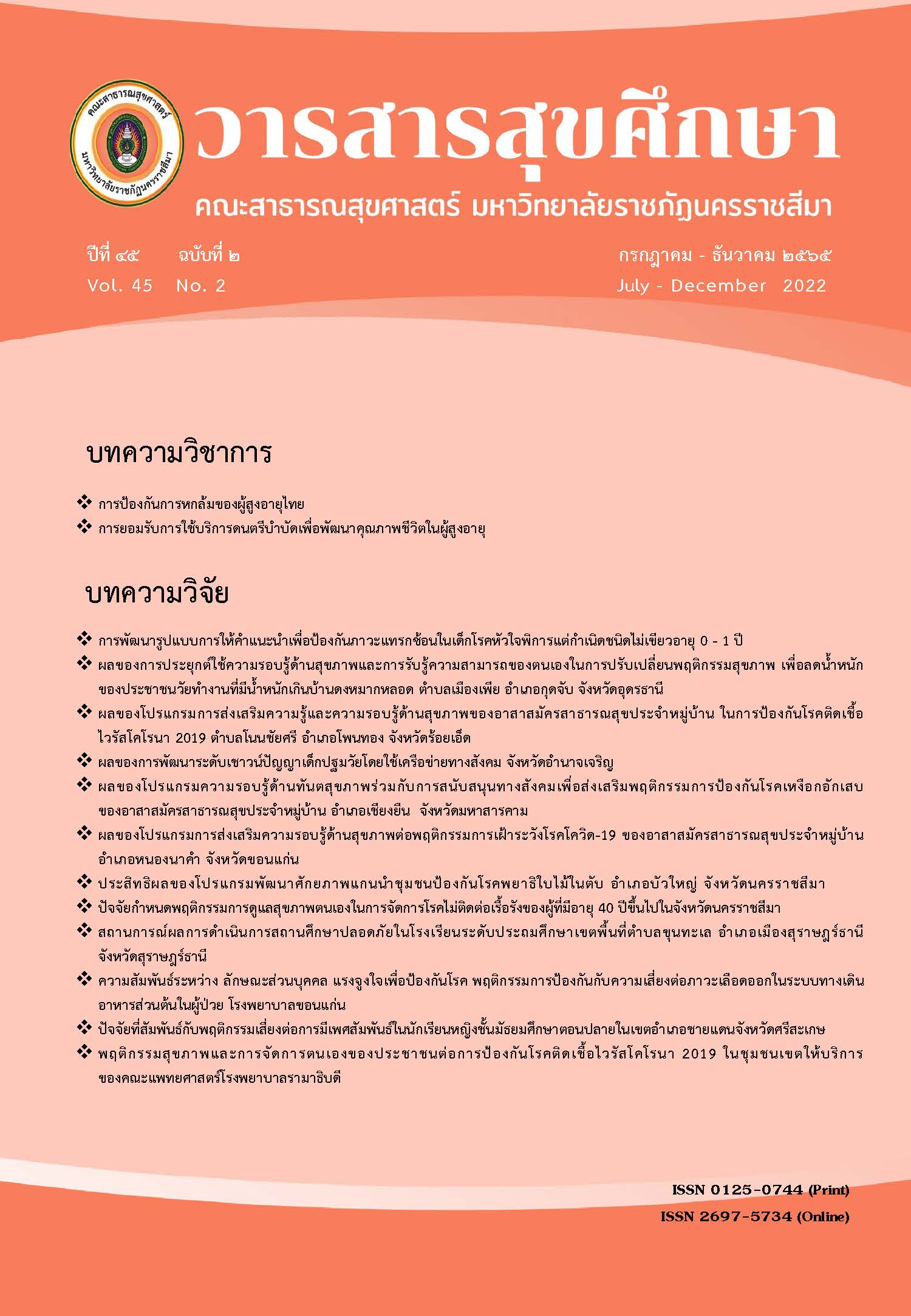Effects of Health Literacy Promotion Program for COVID-19 Surveillance Behavior among Village Health Volunteers in Nongnakhom District Khonkaen Province
Main Article Content
Abstract
COVID-19 is an emerging disease that is considered a major public health problem. Because due to a global pandemic. This research purpose is to study the effects of a health literacy promotion program on COVID-19 surveillance behavior among village health volunteers (VHV) in Bankok Sub-District, Nongnakhom District, Khonkaen Province. This is quasi-experimental research. The subjects were Bankok Sub-District village health volunteers, which consisted of 33 experimental groups, and Kudtad Sub-District village health volunteers, which consisted of 33 compared groups. The experimental group received a health literacy promotion program for the behavior of surveillance for COVID-19 created by researchers, including VHV Access, VHV Understanding, VHV Appraisal, and VHV Application, True operations, Learning summary and the comparison group was encouraged to conduct COVID-19 surveillance according to the standards of the Ministry of Health as usual. It takes 10 weeks to complete the experimental process. Data was collected with questionnaires, including general information, health literacy, and surveillance operations for COVID-19. The data was analyzed using techniques such as the descriptive statistics the independent t-test and paired t-test. The statistical significance level was set at 0.05.
The results found that: 1) After the experiment, the experimental group had average health literacy scores for COVID-19 Surveillance that were statistically significantly higher than the comparison (Mean difference 4.33, 95%CI 3.81–4.79, p<0.001). and were statistically significantly higher than control groups (Mean difference 4.42, 95% CI 3.97–4.87, p 0.001). And 2) After the experiment, the experimental group had an average COVID-19 surveillance operation that was statistically significantly higher than the comparison (Mean difference = 8.33, 95%CI 7.36–9.30, p < 0.001). And they were statistically significantly higher than (Mean difference 10.69, 95% CI 9.70–11.69, p < 0.001). Therefore, Health Literacy Promotion Program on COVID-19 Surveillance Behavior can be applied to develop health literacy in COVID-19 surveillance and behavior of surveillance for COVID-19 in the village health volunteers with the COVID-19 surveillance model “SOB. TID. ROW. MOR3” together with health literacy activities created by the researcher.
Article Details

This work is licensed under a Creative Commons Attribution-NonCommercial-NoDerivatives 4.0 International License.
References
Anuttra Ratnarathon. Coronavirus infectious disease-2019 (COVID-19) : a case report, the first patient in Thailand and outside China. Journal of Bamrasnaradura Infect, 2020; 14(2): 116-23
กรมควบคุมโรค กระทรวงสาธารณสุข. สถาณการณ์ผู้ติดเชื้อ โควิด-19 อัพเดทรายวัน. [อินเตอร์เน็ต]. 2564 [เข้าถึงเมื่อ 31 ตุลาคม 2564]: เข้าถึงได้จาก https://ddc.moph.go.th/viralpneumonia/covid19-dashboard/
สำนักงานสาธารณสุขจังหวัดขอนแก่น. ระบบสารสนเทศโรคติดเชื้อไวรัสโคโรนา 2019 : จังหวัดขอนแก่น. [อินเตอร์เน็ต]. 2564 [เข้าถึงเมื่อ 31 ตุลาคม 2564]: เข้าถึงได้จาก https://covid19.kkpho.go.th/situation
โรงพยาบาลหนองนาคำ. สถานการณ์ COVID-19 อำเภอหนองนาคำ จังหวัดขอนแก่น. [อินเตอร์เน็ต]. 2564 [เข้าถึงเมื่อ 31 ตุลาคม 2564]: เข้าถึงได้จาก https://datastudio.google.com/u/0/reporting
กรมสนับสนุนบริการสุขภาพ. คู่มือ อสม.ยุคใหม่. กรุงเทพฯ: ชุมนุมสหกรณ์การเกษตรแห่งประเทศไทย; 2554
สำนักงานกองทุนสนับสนุนการสร้างเสริมสุขภาพ. รู้ทันภัยข้อมูลภาพออนไลน์. กรุงเทพฯ: สำนักวิจัยและพัฒนาเพื่อการแปลงานวิจัยสุขภาพสู่การปฏิบัติ จุฬาลงกรณ์มหาวิทยาลัย;2559
Sorensen, K., Van den Broucke, S., Fullam, J., Doyle, G., Pelikan, J., Slonska, Z., et al. Health literacy and public health: a systematic review and integration of definitions and models. BMC Public Health, 2012; 12(80): 1-13.
Arunothai Pathan & Sirima Mongkolsomlit. Effectiveness of Mental Health Care Literacy Promotion Program of Elderly People among Village Health Volunteers, Pathumthani Municipalality Province. Journal of Behavioral Science for Development (JBSD), 2020; 12(2): 215-232
เชษฐา งามจรัส. การคำนวณขนาดตัวอย่างสำหรับงานวิจัยด้านวิทยาศาสตร์สุขภาพ. ขอนแก่น: โรงพิมพ์มหาวิทยาลัยขอนแก่น; 2564
เอื้อจิต พูนสุข และคณะ. ผลของโปรแกรมการพัฒนาความรอบรู้ด้านสุขภาพและ พฤติกรรมสุขภาพสำหรับประชาชนกลุ่มวัยทำงาน. วารสารวิชาการสาธารณสุข. 2563: 29 (3): 419-429
อรุณ จิรวัฒน์กุล. สถิติทางวิทยาศาสตร์สุขภาพเพื่อการวิจัย. พิมพ์ครั้งที่ 1. กรุงเทพมหานคร : บริษัทวิทยพัฒน์จำกัด; 2552
Rojanat Choojai, Chonticha Boonsiri and Kamonporn Patcheep. Effects of a Health Literacy Enhancement Program for COVID-19 Prevention on Health Literacy and Prevention Behavior of COVID-19 among Village Health Volunteers in Don Tako Sub-district, Mueang District. The Southern College Network Journal of Nursing and Public Health, 2021; 8(1): 250-262.
Dale, E. Audio-visual methods in teaching (3rded.). New York : Dryden Press;1969
Roger R.W. Protection Motivation Theory Health Education Research Theory and Practice. 1986: 153-161
Kritsapon Thepin, Sutteeporn Moolsart and Napaphen Jantacumma. Effectiveness of a Health Literacy Developmental Program in Patients with Uncontrolled Hypertension. Boromarajonani College of Nursing, Uttaradit Journal, 2019; 11(1): 197-212.


